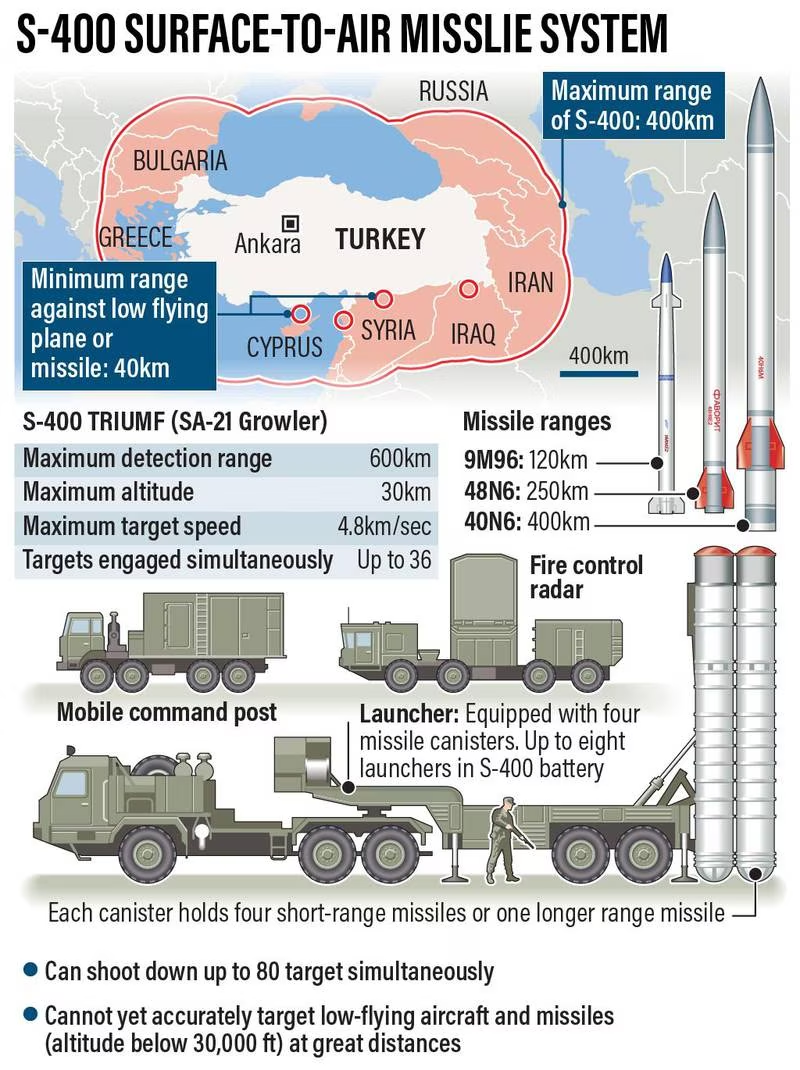S-400 Missile and Project Kusha | 06 Nov 2023
For Prelims: Indian Air Force (IAF), S-400 Triumf Missiles System, Project Kusha
For Mains: Indigenization of Technology, Significance of India's procurement of the S-400 missile system.
Why in News?
The Indian Air Force (IAF) to strengthen its defence capabilities has deployed three S-400 Triumf air defence missile squadrons along the borders with China and Pakistan.
- India in 2018-19 signed a contract with Russia for five S-400 missile squadrons. Three have arrived, and the remaining two are delayed due to Russia-Ukraine conflict.
- In another development, the Indian Defence Acquisition Council recently cleared the procurement of the Indian Long Range Surface Air Missile(LRSAM) system under Project Kusha.
What is the S-400 Triumf Missiles System?
- About:
- The S-400 Triumf is a mobile, surface-to-air missile (SAM) system developed by Russia, capable of intercepting and destroying various aerial targets, such as aircraft, drones, cruise missiles, and ballistic missiles.
- The S-400 has a range of up to 400 km, at an altitude of up to 30 km and can engage up to 36 targets simultaneously, with four different types of missiles.
- It is the most dangerous operationally deployed modern long-range SAM (MLR SAM) in the world, considered much ahead of the US-developed Terminal High Altitude Area Defense system (THAAD).
- Importance for India:
- India decided to procure the S-400 missiles to enhance its air defence capabilities and deterrence posture against China and Pakistan, which have been modernizing and expanding their air forces and missile arsenals.
- India faces a two-front threat from China and Pakistan, which have been involved in several border disputes and conflicts with India over the years.
- India’s acquisition is crucial to counter the growing presence and influence of China in the Indian Ocean Region, where China has been building ports, bases, and infrastructure projects.
- India also wants to maintain its strategic autonomy and diversify its defence partners, amid the uncertainty and volatility of the global order.
- India decided to procure the S-400 missiles to enhance its air defence capabilities and deterrence posture against China and Pakistan, which have been modernizing and expanding their air forces and missile arsenals.
What is Project Kusha?
- Project Kusha led by the Defence Research and Development Organisation (DRDO) is an ambitious defence initiative by India aimed at developing its long-range air defence system by 2028-29.
- Long-range air defence systems will be capable of detecting and destroying enemy projectiles and armour, including cruise missiles, stealth fighter jets, and drones at long range.
- It will consist of three types of interceptor missiles, with ranges of 150 km, 250 km, and 350 km, and advanced long-range surveillance and fire control radars.
- Project Kusha is expected to rival the effectiveness of the renowned S-400 system of Russia and the Iron Dome system of Israel.
Iron Dome System of Israel
- It is a ground-to-air defence system that comprises radar and interceptor missiles that are capable of tracking and neutralising any rockets or missiles fired towards targets in Israel.
- It was developed by the state-run Rafael Advanced Defense Systems and Israel Aerospace Industries and was deployed in 2011.
- It is particularly useful in defending against rockets, artillery and mortars, as well as aircraft, helicopters and unmanned aerial vehicles (UAVs).
- The Dome has a range of close to 70 km and has three crucial components, Detection and Tracking radar, Battle Management and Weapons Control and the Missile Launcher.
UPSC Civil Services Examination Previous Year Question (PYQ)
Q1. What is “Terminal High Altitude Area Defense (THAAD)”, sometimes seen in the news? (2018)
(a) An Israeli radar system
(b) India’s indigenous anti-missile programme
(c) An American anti-missile system
(d) A defence collaboration between Japan and South Korea.
Ans: (c)
Q2. With reference to Agni-IV Missile, which of the following statements is/are correct? (2014)
- It is a surface-to-surface missile.
- It is fuelled by liquid propellant only.
- It can deliver one-tonne nuclear warheads about 7500 km away.
Select the correct answer using the code given below:
(a) 1 only
(b) 2 and 3 only
(c) 1 and 3 only
(d) 1, 2 and 3
Ans: (a)
- Agni-IV is a nuclear-capable long-range ballistic missile of India, with a strike range of 4,000 km.
- The indigenously developed Agni-IV is a two-stage surface-to-surface missile. It is 20 metres long with a weight of 17 tonnes. Hence, statement 1 is correct.
- It is a two stage solid fuelled system that can carry a one-tonne nuclear warhead over a distance of 4,000 kilometres. Hence, statements 2 and 3 are not correct.
- Therefore, option (a) is the correct answer.
Mains
Q. What is the significance of Indo-US defence deals over Indo-Russian defence deals? Discuss with reference to stability in the Indo-Pacific region. (2020)

